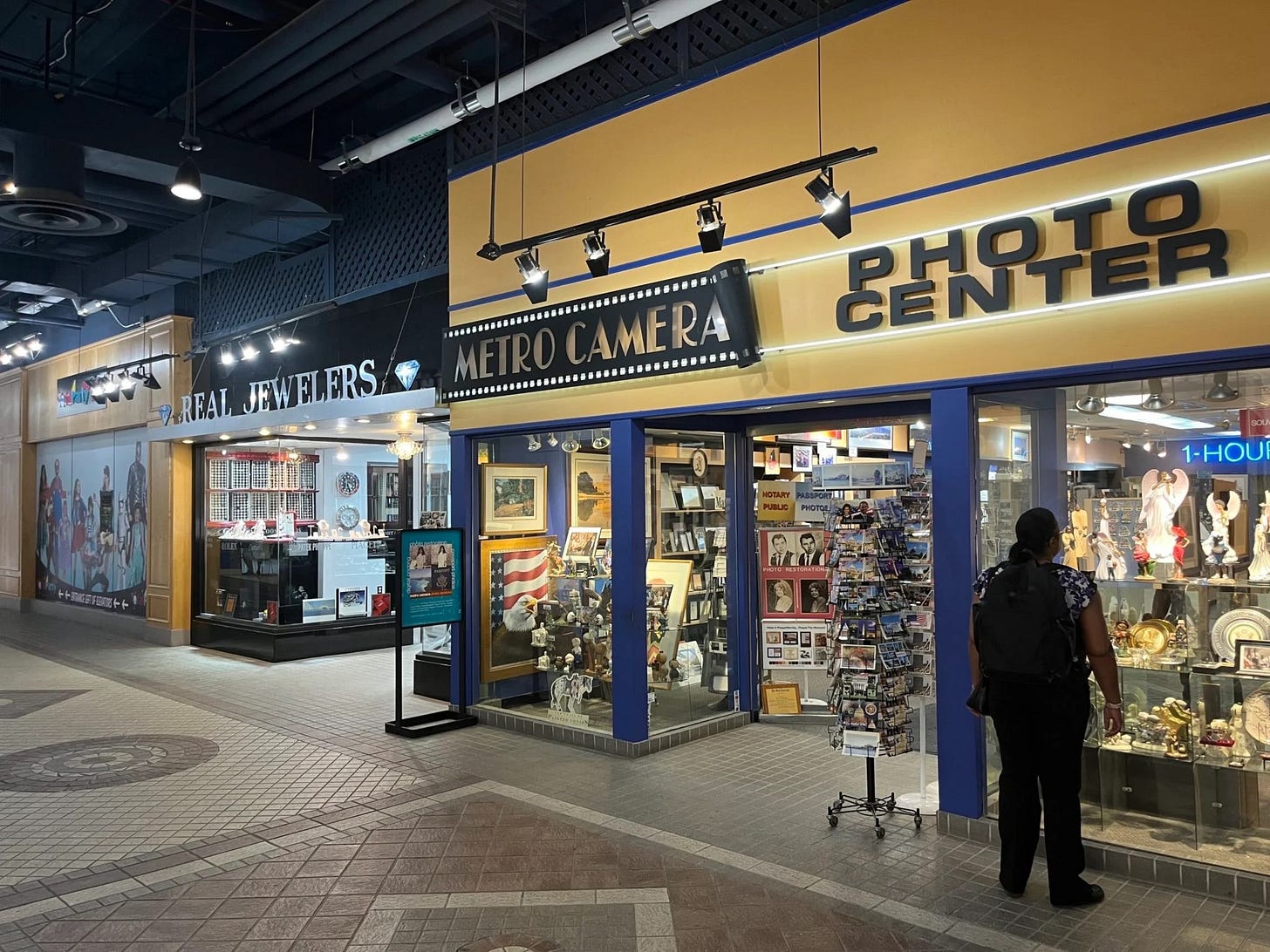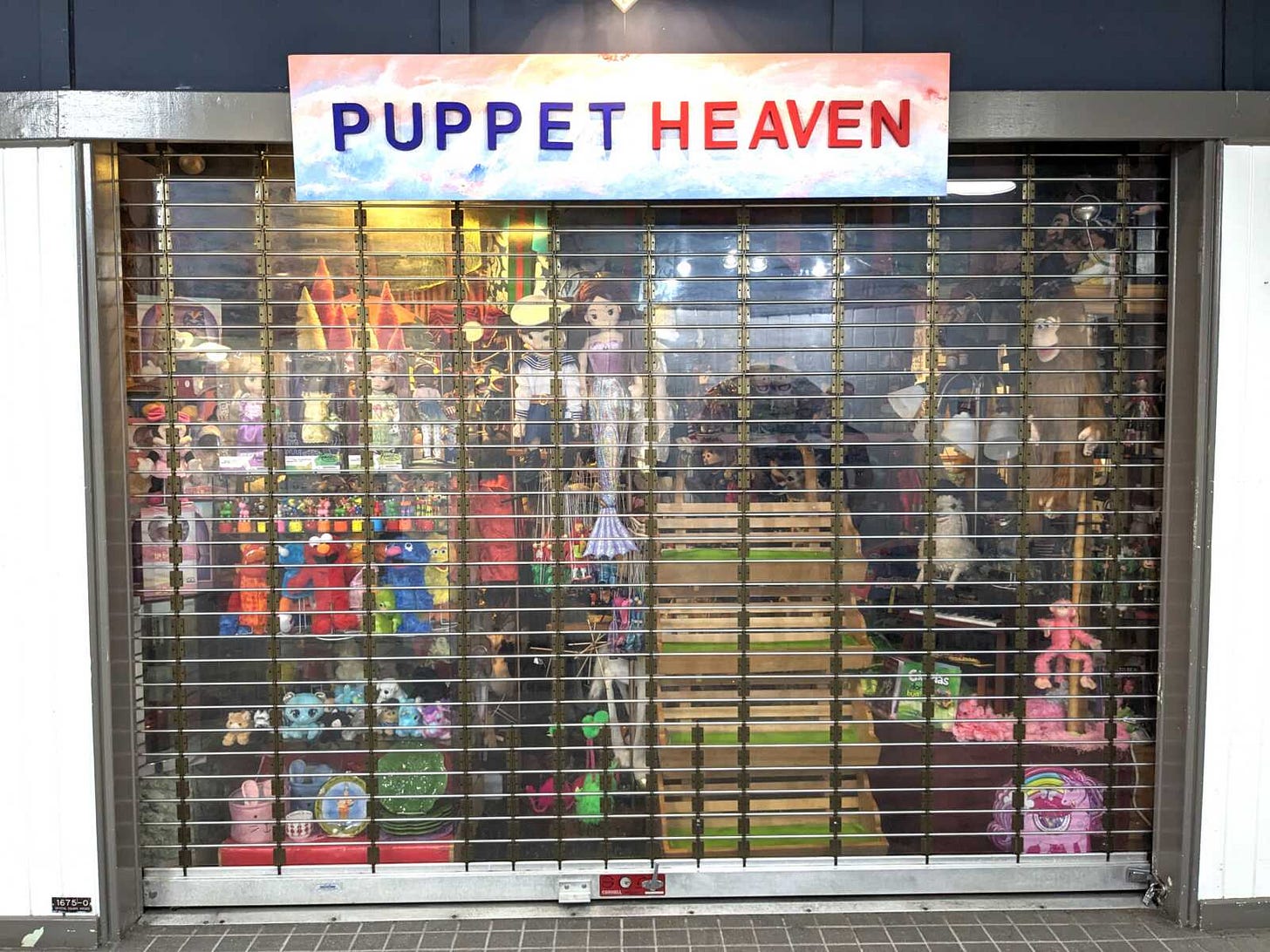Descending from Puppet Heaven
The history and future of the D.C. metro area’s strangest shopping center.
Within the winding bowels of Crystal City’s business-professional weirdness is an essentially foolproof oasis for even the sloppiest of serial killers. The Virginia neighborhood’s disorienting indoor tunnels snake from the metro stop to hoards of office buildings—guiding commuters through a seemingly endless maze of sterile white walls and mostly empty workspaces. The hallways are designed to mimic cobblestone streets, with circular and diamond patterns of muted maroon tiles across a windowless imitation of a subverted Renaissance-era market. Massage parlors and boba tea cafes and all-day sushi stands alike don shield-shaped signs using fonts similar to the style of antique fairytale books. In the areas where there are no stores, wall-sized stock photos of tulips and blue skies provide a half-hearted reminder that somewhere out there, the real world—or some pixelated image of it—is waiting. Standing beneath the tunnels’ harsh fluorescent lighting and dark ceilings, one feels as if they are somehow both everywhere and nowhere, trapped in a gaping liminal chasm.
48 years ago, the vision for the Crystal City Underground Shops was one of a utopia marked by efficiency, innovation and the halfhearted assumption that people would almost always prefer to just stay inside. A sanitized haven for government offices and chandeliered condominiums, the Crystal City neighborhood’s relative charmlessness lent itself to the allure of this new “turn-of-the-century shopping village.” Envisioning a future where a feverish commitment to productivity would render anything outside the office a chronic inconvenience, the Underground Shops aimed to embed capital consumption directly into the workday. Offering everything from grocery shops to camera stores to an entire “Antique Alley” dedicated to handmade crafts, this kooky setup became an eccentric one-stop-shop for even the busiest of commuters.
The Underground’s original 40 stores expanded to over 100 at its peak in the 1990’s, a hallmark era for a bustling brigade of military and defense workers shuffling into minimalist gray offices. But after nearly three decades of expansion, the 2005 Base Realignment and Closure Commission (BRAC) eliminated or relocated 17,000 Crystal City-based jobs—a preliminary nail in the coffin for a neighborhood classified by its walkable proximity to the Pentagon. With 4.2 million square feet of office space now empty, an Arlington County task force sought an avenue for the rebranding and rebirth of an increasingly irrelevant corporate hellscape. In November 2018, it seemed the savior they had been waiting for finally arrived.
After a competitive bid against 238 cities nationwide, relative underdog Crystal City was selected to be the new home of Amazon’s second headquarters, or HQ2. Intending to haul 25,000 new employees into a planned 2.1 million square foot campus, Amazon’s promises of rapid rejuvenation mirrored a city-scale shot of economic botox. But by the time the first offices opened in 2023, company-wide layoffs and hiring slumps left them over half empty, with a pause in construction for an extravagant helix-shaped tower up the street.
And as if that wasn’t enough, think of how detrimental a global pandemic would be for an entire neighborhood designed as a symbiotic parasite to classic conventions of in-person work. As workers retreated to the relative safety of their couches and pajamas, an already crumbling underground world was left barren. As store after store shuttered—or, as one sign reads: MOVED ONLINE!—it became increasingly clear the fabric of traditional commerce was irretrievably coming undone.
This coming October, the Underground Shops will permanently close, repurposing their tunneled halls to be mere walkways with walls of graying, empty storefronts. The fewer than 25 businesses that managed to survive these years of decay have become living artifacts of their own peculiar ecosystem. A store called Total Party—which, to clarify, is not at all total or a party!—offers graduation-themed place settings and three-foot-tall Mickey Mouse balloons. A shuttered location of the fast-casual chain Perfect Pita still retains a haunting wall display that reads: “You are what you eat, so why not be perfect?” Metro Camera and Photo Center sells framed photos of bald eagles and miniature Jesus statues in the architectural style of an abandoned movie-themed Disney World ride. And the grand prix of them all: the ridiculous, quasi-terrifying Puppet Heaven, where slouching marionettes and dead-eyed Elmos forever wait to perform for an empty audience. “Puppet Heaven was absolutely Human Hell,” one Reddit user wrote.
On my first day working at PBS’ Crystal City office, I stepped off the metro and into the alternate universe of the Underground Shops. A summer marked by heat waves that dominated already minimal water-cooler talk, I developed a working fascination with the intricate details of the indoors. I spent arguably too many of my lunch breaks exploring previously unseen hallways, taking photos of customer-less art stores and abandoned food courts to feed my incessant interest in relics of a world long gone. As the PBS Kids staff seven floors above chatted about Mister Rogers’ “Neighborhood of Make Believe,” part of me wondered if I was already standing in it. I imagined horn rimmed glasses and tweed suits darting from store to store, stopping to pick up a new roll of film or a bundle of balloons before heading home to the suburbs.
Human beings have a remarkable ache for shells of the past, living in history that we never saw for ourselves. Kenopsia—defined by the “Dictionary of Obscure Sorrows” as the eerie feeling of an empty place once bustling with people—may just be what has driven 195,000 users to a Reddit thread dedicated to “dead malls.” In the shadow of structures that were once a hub for interpersonal activity and financial prosperity, the irresistible nostalgia of the modern American mall’s decline serves as a testament to the world as we once knew it.
Living through the pandemic made us uncomfortably familiar with the sight of desolate landscapes that were previously epicenters of the everyday human experience. Bustling city streets once too crowded for comfort grew deserted. School desks filled with long overdue homework assignments collected dust. Every seat in every theater was deeply, utterly empty. The temporary apocalypse, as it turned out, was outstandingly quiet.
As we transitioned back into the rhythms of regular life, every space carried a new notion of the before and after. Once thriving local businesses were replaced with new, financially predictable chain cafes. Signs requesting that patrons “mask up” continue to litter the walls of libraries and doctor’s offices and drugstores. Leftover packing tape and barren display cases signal the sweeping breakdown of the Crystal City Underground Shops. And at PBS—where only one day in office per week is required—entire floors of desks covered in Arthur memorabilia and old breaking news alerts look more like a museum about the fun of in-person work.
Entering the professional world amid the transition out of the pandemic, much of Gen Z’s working population is intimately familiar with the collective trauma of Zoom school, internships and therapy sessions. As the days of stay-at-home orders fade into fuzzy repressed memories, a Seramount poll found that 89% of Gen Z-aged respondents prefer being hybrid or fully in-person over working solely remotely. Like the avid posters on r/deadmalls, the generation that will make up 30% of the workforce by 2030 has an insatiable appetite for a time when it made perfect sense to build a mile long tunnel full of novelty stores. As I walked through those hallowed underground halls one last time on the last day of my internship, I realized I was losing more than an odd pastime to tell my roommates about—I, along with every tenant and customer left, were losing the promise that maybe, one day, we could return to the crowded passageways of 1976.
The thorned rose of progress is inescapable; as we become more efficient and globally connected, we endure the whirring cycle of learning and losing what we thought we knew about the commercial world. We appreciate the ability to wear sweatpants all day on a Monday and lament our distance from the days where work was celebrated as a place of unlikely community. We know we will miss the puppet store but we never buy anything from it; we just look into the window and take a photo or two. We forget we hold the power to transform what no longer suits us into something bigger and brighter than a half-finished Amazon headquarters ever could.
In 2020, the National Landing Business Improvement District—which serves, among others, the Crystal City neighborhood—sponsored a community challenge to determine inventive ways to repurpose the tunnels. Despite its reputation as a predominantly corporate office park, respondents highlighted their vision of Crystal City as a quietly blossoming home. Among ideas for hydroponic farms, live music venues and a Museum of Science Fiction, it became increasingly viable that the end of the Underground Shops may be the beginning of a newfound community autonomy. After decades of stories about the bizarre familiarity and warmth of childhood trips to Puppet Heaven or Metro Camera, there is hope for a repurposed path towards a space rooted in our current yearning for human connection and innovation—so long as those in power are willing to honor it.
In a comic strip nodding at the oddities of the Underground Shops, former PBS employee and current professor Linda Simensky wrote:
“I’m not breaking up with Crystal City. In fact, I’d like it to be a little odder than it currently is.”






